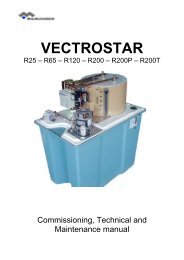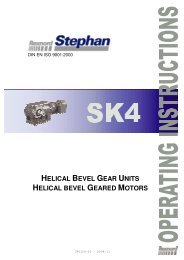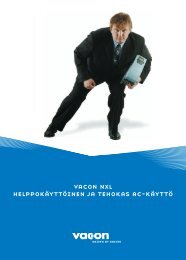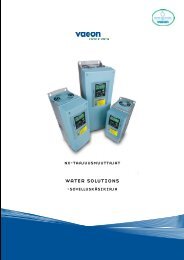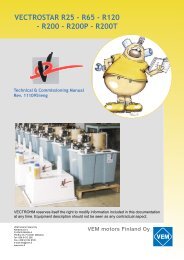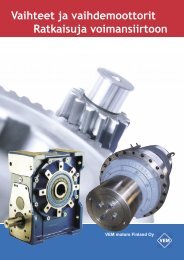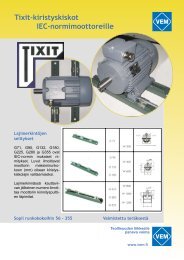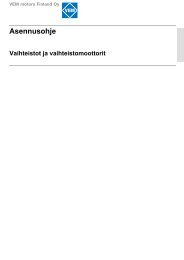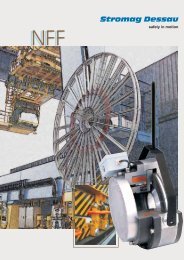Service Instructions
Service Instructions
Service Instructions
You also want an ePaper? Increase the reach of your titles
YUMPU automatically turns print PDFs into web optimized ePapers that Google loves.
<strong>Service</strong> <strong>Instructions</strong> BZFM Stromag DessauIP 54safety in motionElectromagnetic Double - Face Spring-Applied Brake 12.12.2006Contents Chapter PageGeneral hints how to operate the brake 1. 2Conditions of application 1.1. 2Safety guidelines 1.2. 2Safety symbol 1.2.1. 2The "Caution" instruction 1.2.2. 2Safety during operation 1.2.3. 3Transportation 1.3. 3Packaging 1.3.1. 3Pre-mounting condition 1.3.2 3Sensitivity 1.3.3. 4Technical data 2. 4Mechanical data 2.1. 4Electrical data 2.2. 4Torque, speed, technical data 2.3. 5Connecting dimensions 2.4. 5Set up, mode of operation and construction characteristics 3. 6Designation of individual components 3.1 6Function and design characteristics 3.2 7Mechanical release (manual emergency release) 3.3 7Mounting of manual release of BZFM 0,25 – 6,3 3.3.1. 8Mounting of manual release of BZFM 10 – 25 3.3.2. 8Use of microswitches to monitor switching stages (optionally) 3.4. 9Mounting and dismantling of the brake 4. 10Mounting of the brake 4.1. 10Mounting 4.1.1. 10Setting of the friction lining carrier 4.1.2. 10Monitoring of the airgap 4.1.3. 11Setting of the brake torque 4.2. 11Adjusting and re-adjusting of the airgap 4.3. 12Current supplies and electrical connection of the brake 4.4. 12Installation of the rectifier 4.4.1. 13Alternative switching modes to disengage the brake 4.4.2. 14Disengagement on A.C. side when connecting to motor terminal 4.4.2.1. 14Disengagement on A.C. side with separate A.C. feeding 4.4.2.2. 14Disengagement on D.C. side 4.4.2.3. 14Dismantling 4.5. 15Setting into operation 5. 15Operation 6. 15Operating conditions 6.1. 15Duty cycle, switching frequency and times 6.2. 16Trouble shooting 6.3. 16Maintenance 7. 17Spare parts stocking, after-sales service 8. 17Spare parts stocking 8.1. 17Data for the ordering of spare parts 8.2. 18Address of after-sales service 8.3. 19Standards and directives cited 9. 191
<strong>Service</strong> <strong>Instructions</strong> BZFM Stromag DessauIP 54safety in motionElectromagnetic Double - Face Spring-Applied Brake 12.12.20061. General hints how to operate the brake1.1. Conditions of applicationProtection class up to IP 54 in accordance with DIN 40050 (VDE 0470)Electrical design of brakes in accordance with DIN 0580 in insulation class F. The brake correspondsto Directive 93/68/EEC (Low Voltage Directive).Acceptance certificates are deposited with Germanischer Lloyd.In relation to the available mains A.C. voltage, the EMC as per directive 89/336 EEC can be assuredby the user provided that a rectifier module produced by Stromag Dessau GmbH is fitted:-Type EGV 500 (single-way rectifier) assembly into the motor terminal box-Type BG 270 (bridge rectifier) assembly into the motor terminal box.The products are marked accordingly.Mode of operation: S1,S4.Horizontal installation. Vertical operation after consultation with manufacturer.With the friction pairing steel/ organic friction lining the brake may only be used for dry running underthe conditions described in chapter 6..In addition, compliance with the assembly, dismantling, commissioning and installation conditionsspecified by the manufacturer must be ensured.Non-compliance with these conditions or any use beyond this shall be deemed use not inaccordance with the specification.The manufacturer shall not be liable for any such use, the risk shall be exclusively born by the user.If the brake is to be used outside this contractual scope of operation, contact Stromag Dessau GmbHfor further details (address see chapter 8.3).1.2. Safety guidelines1.2.1. Safety symbolThis symbol precedes all safety guidelines in these operating instructions where a dangerto life and limb is involved. Make sure to comply with these guidelines and ensure particular caution.Pass on the safety guidelines to any other users.1.2.2. The "Caution" instructionThe "CAUTION" note will be found in connection with all industrial safety hints which must becomplied with in order to ensure observation of the guidelines, regulations, suggestions and theproper performance of work, as well as in order to prevent damage to or destruction of the brake.2
<strong>Service</strong> <strong>Instructions</strong> BZFM Stromag DessauIP 54safety in motionElectromagnetic Double - Face Spring-Applied Brake 12.12.20061.2.3. Safety during operationMake sure to pay special attention to the following safety hints:The brake is state-of-the-art design and operationally safe. Danger may be caused, however, byimproper operation by unskilled and inadequately trained personnel. Each person in the user'sfactory dealing with the assembly, dismantly, installation or re-installation, commissioning,operation and upkeep (inspection, maintenance, repair) of the brake, must be authorized,properly trained and instructed. He/she must have read and understood the complete operatinginstructions and in particular the safety guidelines.We shall not be liable for any damage or fault caused by non-compliance with the operatinginstructions.Make sure not to operate the brake in such a way that its safety might be impeded.In case the user carries out any modifications which might impede the safety of the brake, he/sheshall immediately notify the supplier of such modification (see chapter 8.3.).The user is obliged to check the faultless condition of the brake before using it.The user shall not carry out any conversions or changes which could impede the safety of the brake,nor shall he/she use any components or accessories from other manufacturers.After electrical installation or repair work, test the protective measures applied (such as groundingresistor).Caution!The user shall always ensure compliance with the local safety and accident prevention rulesduring operation.This brake is subject to technical modifications serving to improve the function and operation of thebrake.We recommend to include these instructions in the operating instructions of the user(machine manufacturer).1.3. Transportation1.3.1. PackagingPackaging will depend on the transportation route and the transport mode. Always ensurecompliance with any symbols attached.1.3.2. Pre-mounting conditionThe add on brakes are used for the convertion of conventional standard motors and gear motors inbrake motors. They are ready for assembly as an compact pre-adjustet brake system usuableindependently and without any mechanical processing work.3
<strong>Service</strong> <strong>Instructions</strong> BZFM Stromag DessauIP 54safety in motionElectromagnetic Double - Face Spring-Applied Brake 12.12.20061.3.3. SensitivityCaution!Make sure to avoid damage as a result of shocks or impacts during transportation. Special careshould be exercised with regard to the radial connecting cable.2. Technical data2.1. Mechanical dataTable 11) 2)Size M N M dyn n 0 n ZN Airgap t 1 t 5 t 5 P VN W J moffstat. min maxBZFM... Nm Nm Min -1 min -1 mm mm ms ms ms kW kJ kgcm 2 kg0,25 3 2,7 3600 2900 0,25 0,4 55 20 120 0,01 4 0,4 1,50,63 6,25 5,7 3600 2900 0,3 0,5 70 25 150 0,015 6 0,9 2,11,6 13,5 12,5 3600 2900 0,3 0,5 85 30 170 0,02 9 2,0 3,02,5 27 24,5 3600 2900 0,3 0,5 125 35 210 0,028 13 3,0 5,04 37 33,6 3600 2900 0,3 0,6 150 40 230 0,033 16 4,6 6,36,3 65 59 3600 2900 0,4 0,7 190 50 260 0,046 22 7,0 9,310 125 113 3600 2900 0,4 0,7 310 60 280 0,09 32 25 14,816 250 220 3600 2900 0,4 0,7 350 70 310 0,11 48 45 22,025 380 345 3600 1450 0,4 0,7 410 80 380 0,14 60 87 31,61) DC-side switching 2) AC-side switching2.2. Electrical dataTable 2aNominalVoltage DCU N = 24 V U N = 95 V U N = 103 V U N = 140 VSize R K I K P K R K I K P K R K I K P K R K I K P KBZFM... Ω A W Ω A W Ω A W Ω A W0,25 29,3 0,82 20 508 0,19 18 664 0,16 16 832 0,17 240,63 24,9 0,96 23 345 0,28 26 524 0,20 20 661 0,20 261,6 18,2 1,32 32 266 0,36 34 415 0,25 26 505 0,26 342,5 14,0 1,70 40 190 0,50 48 294 0,35 36 451 0,31 444 12,0 2,00 48 164 0,58 55 259 0,40 41 320 0,44 616,3 8,9 2,70 65 128 0,74 70 198 0,52 54 251 0,56 7810 7,0 3,44 83 100 0,95 90 124 0,83 86 200 0,70 9816 5,6 4,27 102 84,3 1,13 107 106 0,97 100 160 0,88 12325 4,0 5,94 142 62,6 1,52 144 98,8 1,11 123 163 0,86 1204
<strong>Service</strong> <strong>Instructions</strong> BZFM Stromag DessauIP 54safety in motionElectromagnetic Double - Face Spring-Applied Brake 12.12.2006Tabelle 2bNominalVoltage DCU N = 190 V U N = 207 V U N = 240 VSize R K I K P K R K I K P K R K I K P K R K I K P KBZFM... Ω A W Ω A W Ω A W Ω A W0,25 1566 0,12 23 1937 0,11 22 2429 0,10 240,63 1379 0,14 26 1700 0,12 25 2120 0,11 271,6 967 0,20 37 1237 0,17 35 1609 0,15 362,5 839 0,23 43 1044 0,20 41 1297 0,19 444 615 0,31 59 762 0,27 56 957 0,25 606,3 489 0,39 74 612 0,34 70 766 0,31 7510 391 0,49 92 472 0,44 91 616 0,39 9416 293 0,65 123 375 0,55 114 462 0,52 12525 268 0,71 135 338 0,61 127 433 0,55 133Other voltages on requestM dynM statn 0n zn:dynamic moment (friction moment)applies for dry operation with an oil- and grease-free friction lining afterrunning-in:static moment (moment of adhesion, nominal torque of the brake):max. idling speed:nominal switching speedP k :excitation output at 20°CR K :coil resistance at 20°CI K :energising current at 20°CP vnJWt 1t 5:nominal braking capacity (S4-40% I.O.):mass moment of inertia of rotating parts:switch work per switching operation, mode S2:response delay (time from voltage connection up to the end of armature discmotion):response delay (time from voltage disconnection up to the end of thearmature disc motion):weight of the brakemAC control :via rectifier with the modules type BG 270, EGV 500,The main parameters of the brakes are also given on the rating plate.2.3. Torque, speed and other technical dataAdmissible torques and other technical data are given in the tables of chapter 2.a. and 2.b.Any technical parameters deviating from the values given in the table may be requested from themanufacturer or form part of the order acknowledgement.2.4. Connecting dimensionsThe connecting dimensions correspond to the IEC standard and DIN 42948 are given on thedimensional sheets “BZFM” M8-307 and M8-314 (appendix).5
<strong>Service</strong> <strong>Instructions</strong> BZFM Stromag DessauIP 54safety in motionElectromagnetic Double - Face Spring-Applied Brake 12.12.20063. Setup, mode of operation and construction characteristics3.1. Designation of individual components28032702Manual release(option)15fig. 1aBZFM 0,25 – 6,320XXX28030105262505 060424230914XXXAirgap offManual release(option)101213190807011510060807131901 coilbody02 armature disc03 N-side end plate04 friction lining carrier05 friction lining06 coil07 pressure spring08 spring bolt09 adjusting screw10 head bolt11 mounting screw12 adjusting ring13 sealing ring14 rubber collar15 identification plate19 shaft extension20 fan cover23 thread for „jack off“ screws24 groove nut25 pilot hole26 bearing27 cylindric screw28 connection cable040209120120Fig. 1bBZFM 10 - 2514Airgap off276
<strong>Service</strong> <strong>Instructions</strong> BZFM Stromag DessauIP 54safety in motionElectromagnetic Double - Face Spring-Applied Brake 12.12.20063.2. Function and design characteristics (fig. 1a and fig. 1b)The brake BZFM is a spring loaded electromagnetic double-face brake which brakes without currentand is released electromagnetically.The coilbody (01) contains a coil (06) which is potted with an synthetic resin compound inaccordance with insulating material class F, (max. limit of temperature 155°C).If the coil (06) is not excited, the springs (07) which are situated in the internal and external pole,press the armature disc (02) against the floating formated with friction lining carrier (04). Thus isfirmly clamped between the torsion-protected armature disc (02) and the N-side end plate (03) andthus prevented from rotating. At the sizes 0,25 – 6,3 the generated brake torque is transmitted via aninterference –fit tapered arrangement, while at the sizes 10 – 25 the torque is transmitted by anadhesive bonded joint from the friction lining (05) via the friction lining carrier (04).If the coil (06)is connected to a direct voltage as specified on the identification plate (15) or about aStromag rectifier set (see also chap.2.2) to a alternating voltage, the magnetic force will draw thearmature disc (02) to the coilbody (01) against the spring pressure (07). The friction lining (05) isreleased, the braking is cancelled and the brake is released.3.3. Mechanical release (emergency release) (optional)The brakes are constructed in such a way that any necessary manual release can be added withoutthe need for any machining processes.The manual release is to be used for the mechanical release in the case of emergency or for theadjusting of the system.Size 0,25 – 6,3 Size 10 - 25figure 2afigure 2b4545XXX46XXX4002a=0.6424042a=0.6mm414849414443Luftspalt aus01440201Airgap off7Luftspalt ausAirgap off
<strong>Service</strong> <strong>Instructions</strong> BZFM Stromag DessauIP 54safety in motionElectromagnetic Double - Face Spring-Applied Brake 12.12.200601 coilbody 44 compession spring02 armature disc 45 lever40 stirrup 46 rubber plate41 hexagon screw or bolt 48 straight grooved pin42 self locking nut 49 grooved drive stud43 washer3.3.1. Mounting of manual release for the sizes BZFM 0,25 - 6,3 ( fig. 2a )The manual release is not self-locking and is mounted as follows:- Remove the fan cap from the brake and break-out the pre-punchings in the fan cap provided forthe manual release.- Unscrew the complete coil body assy (coil body (01) and armature disc (02)) from the N-side endplate (03).- Fit the two hexagon screws (41) (2x180°) with washer (43) and pressure spring (44) into the coilbody (01) coming from the armature disc (02).- Mount the complete coil body with the fitted hexagon screws (41) and N-side end plate (03) to themotor or to the pertinent machine part resp.- Place the stirrup (40) on coil body side onto the standing proud screws (41) into the accordinglyprovided millings.- Fix the stirrup (40) by a self-locking nut (42) each on the two screws (41) and adjust the dimensiona = 0,6 mm (fig. 2a) with unreleased brake (airgap „off“ as per table 1 chap. 2.1.).- Mount the fan cap to the brake.- Screw the lever (45) into the accordingly provided thread of the stirrup (40).3.3.2. Mounting of the manual release for the sizes BZFM 10 - 25 ( fig. 2b )The manual release can be mounted without necessity to dismantle the brake.It is not self-locking and is mounted as follows:- Remove the fan cap from the brake and break-out the pre-punchings in the fan cap provided for themanual release.- Insert the pressure springs (44) into the accordingly provided bores (2x180°)- Place the stirrup (40) onto the coil body (01) into the accordingly provided millings (2x180°).- Put the bolt (41) with straight grooved pin (48) through the stirrup and the coil body.- Screw the nuts (42) onto the thread of the bolt (41) on armature disc side and adjust the dimensiona = 0,6 mm (fig. 2b) with unreleased brake (airgap „off“ as per table 1 chap. 2.1.).- Mount the fan cap to the brake. Thereby the connection piece of the stirrup (40) of the manualrelease stands proud the recess of the fan cap.- Push the rubber plate (46) onto the connection piece of the stirrup (40) of the manual release onthe fan cap up to limit stop.- Only when intended to release the brake mechanically, fit the lever (45) into the connection piece ofthe stirrup (40).8
<strong>Service</strong> <strong>Instructions</strong> BZFM Stromag DessauIP 54safety in motionElectromagnetic Double - Face Spring-Applied Brake 12.12.2006Manual emergency release shall not be used to maintain temporary operation! The wearof the friction lining has to be re-adjusted timely according as per identification plate and technicaldata sheet, otherwise the braking effect will be cancelled by the screw or bolt (41) of the manualrelease.3.4. Use of microswitches to monitor switching stages (optionally)If the switching condition of the brake should be controlled a microswitch is used according fig.3. Themicroswitch prevents the motor by an additional locking switch from starting before the brake hasbeen released.03170204Airgap offLuftspalt aus1618010601 coil body02 armature disc03 N-side end plate04 friction lining carrier05 coil16 micro switch17 distance bolt18 hexagon nutFigure 3When the armature disc (02) is moved against the coil body (01) as a result of the electro-magneticforce of the coil (06) or the actuation of the mechanical emergency release device, (chap. 3.3.), it willoperate a microswitch (16) via the distance bolt (17). Its switchpoint is located at the half of the "offmin" airgap (chap 2.1).The microswitch may be included in the control circuit of the motor contactor as a normally open ornormally closed contact.9
<strong>Service</strong> <strong>Instructions</strong> BZFM Stromag DessauIP 54safety in motionElectromagnetic Double - Face Spring-Applied Brake 12.12.20064. Mounting and dismantling of the brake(Individual parts with Item-No. see chapt. 3.1.)The brake is screwed to the motor by the attached mounting screws (11). After having mounted thebrake, check the airgap and correct it, if necessary (see chap. 4.3.).4.1. Mounting of the brake4.1.1. Mounting- Remove the fan cover of the motor and the N-side end plate of the motor- Check the shaft end for burr, any grease and adherence to dimensions (see dimensionalsheet M8-307 and M8-314 d 2- loose and remove the fan cover of the brake (20)- remove the rubber collar (14)remove the adjusting ring (12)Attention!During the pre-mounting don´t change the adjusting screws (09) as well as the cylindricscrews (10) because the working airgap is already adjusted. Mounting in vertical position ifpossible.- check the motor shaft for impact damages- placing the brake on the motor in such a way that the brake´s cable entry is at an angle ofabout 45 ° to the motor terminal box and the shaft extension (19) is to put off the motor shaftend easily- fasten the brake to the motor by the attached mounting screws (11).(when using 3 point N-side end plate the mounting screws are attached)4.1.2 Setting the friction lining carrier- to ensure maximum wear from the friction lining (05) on the sizes 0,25 to 6,3 the friction liningcarrier (04) should be set initially with the aid of feeler gauges or thickness gauges to thepreset dimension (table 3) by gently tightening the groove nut (24).- after removing the feeler gauges the groove nut (24) must be tightened with the minimumwrench torques given in table 4 to ensure transmission of the braking torque. The pre setdimension is reduced to the distance “A” given in fig. 2a according table 3.- on the sizes 10 to 25 the N-side shaft and hub bore should be carefully degreased beforeadhesive is applied. A coating of metal adhesive (e.g. Loctite 638) should be applied afterwhich the brake should be placed on the hub up to the shaft collar or centring collar, rotatingduring the process.- this results in a constant value for the distance “A” (fig. 2b, table 3).- where more exacting safety requirements apply, the adhesive-bonded components may bepinned together in the pilot hole (25).10
<strong>Service</strong> <strong>Instructions</strong> BZFM Stromag DessauIP 54safety in motionElectromagnetic Double - Face Spring-Applied Brake 12.12.2006Table 3 Table 4Size BZFM Distance for „A“ Pre-set dimensionin mmin mm0,25 up to 1,6 1,5 - 0,3 2,02,5 up to 6,3 1,8 - 0,3 2,510 up to 25 2 ± 0,5 -0,250,631,62,546,3Size BZFMwrench torquein Nm203050801201504.1.2. Monitoring of the airgapAfter the installation of the brake the control of the airgap “off” must be taken minimal on two placesbe opposited between the coilbody (01) and the armature disc (02) when the coil is currentless.The airgap must be in accordance with the airgap “min” according table 1 chap. 2.1.In the case of any deviation the airgap has to re-adjusted described in chap. 4.3.4.2. Setting the brake torqueThe torques given in the technical data (chap. 2.1.) were obtained only by fully tighteningthe adjusting ring (12).0701b120801 coil body07 pressure spring08 spring bolt12 adjusting ringFigure 4A reduction can be made according figure 4 and table 5 up to a value of 0,55 x M N.table 5Luftspalt ausAirgap offsize BZFM...V7 0,25 0,63 1,6 2,5 4 6,3 10 16 25Reduction Dimension b in mm (figure 4)M N Nm 3 3 3 3 3 3 5 5 50,90 x M N Nm 3,65 3,65 3,95 4,15 4,15 4,50 6,60 6,90 6,700,80 x M N Nm 4,30 4,30 4,90 5,30 5,30 6,00 8,10 8,80 8,300,70 x M N Nm 4,95 4,95 5,85 6,45 6,45 7,50 9,70 10,70 10,000,60 x M N Nm 5,60 5,60 6,80 7,60 7,60 9,00 11,20 12,60 11,600,55 x M N Nm 5,95 5,95 7,30 8,20 8,20 9,70 12,00 13,55 12,4511
<strong>Service</strong> <strong>Instructions</strong> BZFM Stromag DessauIP 54safety in motionElectromagnetic Double - Face Spring-Applied Brake 12.12.20064.3. Adjusting and re-adjusting of the airgapThe airgap of the brake must be re-adjusted, if:- deviations from airgap „off min“ are noted on mounting- friction lining wear occurred after application of the brakeImportant note!Check up: The brake must be torque free on the output side!Disconnect the brake from current (from size 6.3 protect by stopping means), than dismantle as perchap. 4.5.Adjusting and re-adjusting of the airgap: (proceed according fig.1)- measuring of the airgap- loosen the cylindric screws (10) for 1-2 revolutions- screw-in uniformly the three adjusting screws (09) by the difference from the measuredairgap „off min“ ”Aus min” as per rating plate (15)Important note!¼ revolution of the adjusting screw correspondence to ca.0,25 mm.- tighten the cylindric screws (10)- control the airgap. The airgap should correspondence to the airgap “off min” shown in the table 1- if necessary repeat the correcture of the airgap- The airgap of the brake can be re-adjusted several times until the lower wear limit of the frictionlining (05) is achieved (minimum thickness of the friction lining see table 6)table 6Size BZFM.. 0,25 0,63 1,6 2,5 4 6,3 10 16 25Min. thickness of frictionliningmm 5,5 5,5 5,5 7,5 7,5 7,5 11 11 11Maximum of wear mm 1,5 1,5 1,5 2,5 2,5 2,5 3 3 34.4. Current supplies and electrical connection of the brakeMake shure that the electrical connection is performed by expert personnel taking into account theinstallation regulations (such as DIN IEC 92).The brakes can be connected to A.C. voltage through a rectifier module EGV 500 or BG 270 of thecompany Stromag Dessau GmbH, in compliance with the technical data (e.g. table 2).This rectifier module can also be integrated in the terminal box of a motor.The coil has been designed for 100% duty factor and connection to D.C. supply only, given on theidentification plate (residual ripple< 0.5).According to DIN VDE 0580 the permanently admissible voltage change is +5% to –10% of thenominal voltage.The connection system is shown in fig.5a and 5b.12
<strong>Service</strong> <strong>Instructions</strong> BZFM Stromag DessauIP 54safety in motionElectromagnetic Double - Face Spring-Applied Brake 12.12.2006bridgeU~inputvoltageU-brakeU~inputvoltagebridgeU brakefigure 5a one way rectification Figure 5b bridge rectificatione.g. with type EGV 500 e.g. with type BG 2704.4.1. Installation of the rectifierThe rectifier module can be mounted in the terminal box of the motor eg. as shown in figure 6figure 601 terminal block03 mounting screw04 contact bridgeTable 7The terminal contacts are assigned as follows:Contact Symbols Assignment of contactsK1 ; K2 ∼ ; ~ AC supply (K1 – phase conductor;K2 - N / PEN)K3 ; K4 - ; + DC output brakeK5 ; K6Auxiliary contact connection (only withDC –side switching)13
<strong>Service</strong> <strong>Instructions</strong> BZFM Stromag DessauIP 54safety in motionElectromagnetic Double - Face Spring-Applied Brake 12.12.20064.5. DismantlingDismantling is subject to the same instructions and regulations as installation. Carry out theoperations in inversed order of succession!Important note!Check up: The brake must be torque-free on the output side.Before removing the brake, disconnect it from the mains and secure with slings.5. Setting into operationCaution!During start-up, please note that a new friction lining will not transmit the full braking torque.This will only be realised after a number of braking operations under normal operating conditions, i.e.after smoothening of the friction surfaces.6. OperationNotwithstanding any instructions given below, operation of the brake must alwayscomply with local mandatory safety and accident prevention rules. Compliance with these rules shallbe ensured by the user.6.1. Operating conditionsThe operating conditions to be maintained for a faultless operation of the brake, are given below:- The operating temperature should not be below –30°C and not above +50°C.- In the case of higher and/or lower ambient temperatures, please contact our after-salesservice (for address see Chapter 8.3).- Air humidity may be 100%.15
<strong>Service</strong> <strong>Instructions</strong> BZFM Stromag DessauIP 54safety in motionElectromagnetic Double - Face Spring-Applied Brake 12.12.20066.2. Duty cycle, switching frequencyThe design as well as admissible loads on brakes as per braking torque, speed, switching capacityare given under „Technical Data“ (see Chapter 1) and the dimensional drawing (appendix). If any ofthese data are exceeded consult the manufacturer.6.3. Trouble shooting (individual parts with Item-No. see chapter 3)Fault Possible causes RemedyInsufficient braking effectFriction surfaces are not freefrom greasechange friction lining (05)Brake not completely run-inBrake has been overloadedAdjusting ring (12) not turned-inor partly turned-in only.Let brake run inReplace brakeTurn in the adjusting ring (12)(chap. 4.2.)No braking effectBrake does not releaseIdle-run torque of the braketoo highThe stirrup (40) of the manualrelease squeezesAirgap „off“ air gap too largedue to wear of friction liningMount the manual releasecorrectRe-adjust brake (chapter 4.3)Replace friction lining (05)Armature disc (02) distorted Replace brake (Chapter 4)Coil connecting voltage too lowCheck DC voltage supplyCoil (06) defective Replace brake (chapt. 4)Rectifier module defectiveFeed line defectiveContact points looseSpring rupture or foreignparticles in the airgapAirgap “off” too smallReplace rectifier moduleRenew feed lineRe-tighten contact pointsDismantling of brake,contact manufactureradjust the airgap (chapt. 4.3.)16
<strong>Service</strong> <strong>Instructions</strong> BZFM Stromag DessauIP 54safety in motionElectromagnetic Double - Face Spring-Applied Brake 12.12.20067. MaintenanceMake shure to comply with chapt. 1 “Safety guidelines” during all maintenance andinspection work.As the brakes work under varying operation conditions, it is not possible to pre-define wear check,inspection maintenance and repair intervals.Higher loads on the brakes (e.g. as a result of torque, speed, switching frequency, ambienttemperature etc.) require shorter maintenance intervals.Therefore it is first of all necessary to observe the brake with regard to safety and wear, and thenadapt the maintenance intervals in accordance with the observation made.Wear of the friction lining will result as a greater air gap “off”Depending on the load of the brake, the air gap must be checked from time to time. This will be doneby measuring of the air gap according to chapter 4.1.3.If the max. airgap as determined in chap. 2 (table 1) is reached please readjust the airgap describedin chap. 4.3.Caution!If the wear re-adjustment is not carried out early enough, both the transmission of the rated loadtorque and the lifting of the brake will not be ensured.8. Spare parts stocking, after sales-service8.1. After-sales serviceStocking of spare and parts subject to wear is an important precondition for permanet an reliablefunctioning of the brake.friction lining carrier (04), friction lining (05) and armature disc (02), (for item see chapter 3.1.) areparts subject to wear.Warranty will be provided only for the original spare parts supplied by us. We expressly state that theinstallation or use of spare parts other than the original ones supplied by us will negatively affect thedesign characteristics of the brake and thus have an impact on active and/or passive safety.Stromag Dessau GmbH shall have no warranty obligations for any damage caused by the use ofspare parts or accessories other than the original ones supplied by us.Please bear in mind that often particular manufacturing and delivery specifications exist for partsmanufactured by us or bought from others, and that we offer spare parts to the up-dated technicalconditions and the up-dated legal prescriptions.17
<strong>Service</strong> <strong>Instructions</strong> BZFM Stromag DessauIP 54safety in motionElectromagnetic Double - Face Spring-Applied Brake 12.12.20068.2. Data for the ordering of spare partsPlease specify the following details when ordering spare parts:- Series and size of brake- Consignment / fabrication number- Location and designation of spare part- Number of piecesDesignation of individual parts01 Coil body02 Armature disc03 N-side end plate04 friction lining carrier05 Friction lining06 Coil07 Compression spring08 Spring bolt09 Adjusting screw10 Cyl. screw11 Mounting screw12 Adjusting ring13 sealing ring14 rubber collar15 identification plate16 microswitch17 distance bolt18 hexagon nut40 stirrup for manual release41 hexagon head screw42 self-locking nut or castel nut43 washer44 compression spring45 lever for mechanical release46 rubber plate48 straight grooved pin49 grooved drive stud18
<strong>Service</strong> <strong>Instructions</strong> BZFM Stromag DessauIP 54safety in motionElectromagnetic Double - Face Spring-Applied Brake 12.12.20068.3. Address of after-sales serviceThis is our address for after-sales service and spare parts distribution:Stromag Dessau GmbHDessauer Straße 10D-06844 DessauGermanyphone: (49) (0)340/2190-203Fax: (49) (0)340/2190-201E-mail: vertrieb.dessau@stromag.comInternet: http://www.stromag-dessau.deIf you require a service engineer, please contact our "Technical after-sales service" under the aboveaddress.9. Standards and directives citedDIN 6885DIN 40050DIN 42948DIN 42955DIN IEC 92DIN VDE 0530DIN VDE 0580VDE 0660 T 200/09.82,89/336/EEC (EMC)93/68/EECSheet 1 Fitting keys(VDE 0470) Protection classesFastening flanges for electrical machinesConcentricity of shaft ends, co-axial and true running offastening flanges of rotating electrical machinesElectrical equipment on shipsRotating electrical machinesRegulations for electrical devicesSection 4.2.4, Table 1 - Inductive loadElectromagnetic compatibilityLow Voltage Directive19



